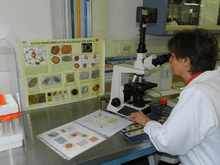Indicator organism
Indicator organisms are used as a proxy to monitor conditions in a particular environment, ecosystem, area, habitat, or consumer product. Certain bacteria, fungi and helminth eggs are being used for various purposes.
Types
Indicator bacteria
Certain bacteria can be used as indicator organisms in particular situations. The presence of bacteria commonly found in human feces, termed coliform bacteria (e.g. E. coli), in surface water is a common indicator of faecal contamination. For this reason, sanitation programs often test water for the presence of these organisms to ensure that drinking water systems are not contaminated with feces. This testing can be done using several methods which generally involve taking samples of water, or passing large amounts of water through a filter to sample bacteria, then testing to see if bacteria from that water grow on selective media such as MacConkey agar. Alternatively, the sample can be tested to see if it utilizes various nutrients in ways characteristic of coliform bacteria.[1]
Coliform bacteria selected as indicators of faecal contamination must not persist in the environment for long periods of time following efflux from the intestine, and their presence must be closely correlated with contamination by other faecal organisms. Indicator organisms need not be pathogenic.[2]
Non-coliform bacteria, such as Streptococcus bovis and certain clostridia may also be used as an index of faecal contamination.[3]
Indicator fungi
Penicillium species, Aspergillus niger and Candida albicans are used in the pharmaceutical industry for microbial limit testing, bioburden assessment, method validation, antimicrobial challenge tests, and quality control testing.[4] When used in this capacity, Penicillium and A. niger are compendial mold indicator organisms.[4]
Molds such as Trichoderma, Exophiala, Stachybotrys, Aspergillus fumigatus, Aspergillus versicolor, Phialophora, Fusarium, Ulocladium and certain yeasts are used as indicators of indoor air quality.[5][6][7]
Indicator helminth eggs

Helminth eggs (or ova) are a good indicator organism to assess the safety of sanitation and wastewater reuse systems for resource recovery because they are the most environmentally resistant pathogens of all pathogens (viruses, bacteria, protozoa and helminths) and can in extreme cases survive for several years in soil.[8]
See also
- Coliform bacteria
- Coliform index
- E. coli
- Indicator species
References
- Ashbolt NJ, Grabow WO, Snozzi M. "13: Indicators of microbial water quality". Assessing Microbial Safety of Drinking Water (PDF). World Health Organization. pp. 293–295. Retrieved 16 July 2016.
- "Fecal Coliform as an Indicator Organism" (PDF). Wastewater treatment environmental fact sheet. New Hampshire Department of Environmental Services. 2003. Retrieved 30 November 2007.
- Gerardi, Michael H.; Mel C. Zimmerman (January 2005). Michael H. Gerardi (ed.). Wastewater Pathogens. Wastewater Microbiology Series. Hoboken, NJ: John Wiley & Sons, Inc. p. 147. ISBN 978-0-471-20692-7.
- Clontz, Lucia (2009). "Microorganisms of interest". Microbial Limit and Bioburden Tests: Validation Approaches and Global Requirements, Second Edition (2nd ed.). Boca Raton, Florida: CRC Press. pp. 31–33. ISBN 9781420053494.
- Jantunen, Matti; Jaakkola, Jouni J. K.; Krzyzanowski, M., eds. (1997). "20: Bacteria and fungi". Assessment of Exposure to Indoor Air Pollutants, WHO Regional Publications European Series, No. 78. Copenhagen: WHO Regional Office Europe. pp. 101–102. ISBN 9289013427.
- Cole, Eugene C.; Dulaney, Pamela D.; Leese, Keith E.; Hall, Richard M.; Foarde, Karin K.; Franke, Deborah L.; Myers, Frank M.; Berry, Michael A. (1996). "Biopollutant Sampling and Analysis of Indoor Surface Dusts: Characterization of Potential Sources and Sinks". In Tichenor, Bruce A. (ed.). Characterizing Sources of Indoor Air Pollution and Related Sink Effects, Volume 1287. West Conshohocken, PA: ASTM International. pp. 164–164. ISBN 9780803120303.
- Heikkinen, M.S.A.; Hjelmroos-Koski, M.K.; Haggblom, M.M.; Macher, J.M. (2004). "Chapter 13: Bioaerosols". In Ruzer, L.S.; Harley, N.H. (eds.). Aerosols Handbook: Measurement, Dosimetry, and Health Effects. Boca Raton, Florida: CRC Press. pp. 377–378. ISBN 9780203493182.
- WHO (2006). Guidelines for the Safe Use of Wastewater, Excreta and Greywater, Volume 4 Excreta and Greywater Use in Agriculture (third ed.). Geneva: World Health Organization. ISBN 9241546859.